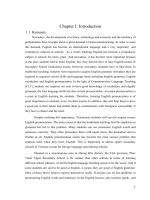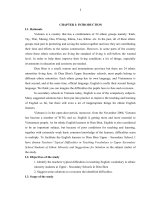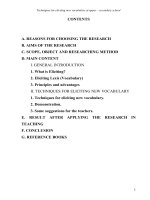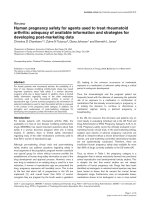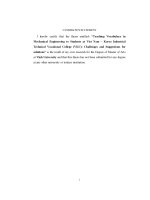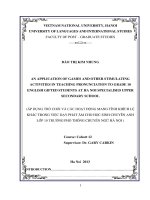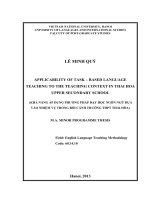Teachers' typical difficulties in teaching vocabulary to upper secondary school students of ethnic minority and suggestions for solution
Bạn đang xem bản rút gọn của tài liệu. Xem và tải ngay bản đầy đủ của tài liệu tại đây (319.54 KB, 42 trang )
1
Chapter I: introduction
I.1. Rationale
Vietnam is a country that has a combination of 54 ethnic groups namely: Kinh, Tay,
Thai, Muong, Dao, H'mong, Khmu, Lao, Khme. etc. In the past, all of these ethnic groups
took part in protecting and saving the nation together and now they are contributing their
time and efforts to the nation construction. However, in some parts of the country where
these ethnic minorities are living the standard of living is still bellow the wanted level. In
order to help them improve their living conditions a lot of things, especially investments in
education and economy are needed.
Dien Bien is a small, remote and mountainous province but there are 24 ethnic
minorities living here. At Dien Bien's Upper Secondary schools, most pupils belong to
different ethnic minorities. Each ethnic group has its own language, and Vietnamese is their
second, and at the same time, official language. English is really their second foreign
language. We think you can imagine the difficulties the pupils have to face and overcome.
In secondary schools in Vietnam today, English is one of the compulsory subjects.
Many suggested solutions have been put into practice to improve the teaching and learning
of English so far, but there still exist a lot of inappropriate things for ethnic English learners.
Vietnam is in the open-door period, moreover, from the November 2006, Vietnam
has become a member of WTO, and so, English is getting more and more essential to
Vietnamese people. As for ethnic English learners in Dien Bien, English is also considered
to be an important subject, but because of poor conditions for teaching and learning, together
with extremely weak basic common knowledge of the learners, difficulties seem to multiply.
To facilitate the English learners in Dien Bien Upper - Secondary School, I have chosen
Teachers' Typical Difficulties in Teaching Vocabulary to Upper Secondary School Students
of Ethnic Minority and Suggestions for Solution as the subject matter of the study.
I.2. Objectives of the study
1. Identify the teachers' typical difficulties in teaching English vocabulary to ethnic
minority students at Upper - Secondary Schools in Dien Bien
2. Suggest some solutions to overcome the identified difficulties.
I.3. Scope of the study
2
The study only concentrates on the teaching and learning English vocabulary from
textbooks “Tiếng Anh 10”, “Tiếng Anh 11” (used in Upper - Secondary Schools throughout
Vietnam).
I.4. Method of the study
The study uses a combination of various methods to achieve its objectives such as
descriptive, comparative and statistical. Various sources of data, including those obtained
from the students and teachers in the Upper – Secondary Schools in Dien Bien, were
collected.
First, survey questionnaires were conducted. Data obtained help to design the final
survey questionnaires to investigate teachers and students’ comments and attitudes towards
teaching and learning English vocabulary in Upper-Secondary Schools in Dien Bien as well
as their perceived challenges.
After that, observing classes were organized to find out how effectively the students
learn English vocabulary.
Next, the researcher visited the students' families in order to get a deeper
understanding about these students' real lives. From this information, the author could
reinforce his understanding about this matter.
Finally, the author interviewed the teachers who are teaching English in Upper Secondary Schools in Dien Bien and some ethnic students to get better insights into the
research questions.
3
Chapter II: Literature review
II.1. Vocabulary and its significance in language teaching and learning
II.1.1 what is vocabulary?
Vocabulary is a matter which many linguists and language teachers have been
concerned for a long time. Nevertheless, to provide an exact definition of vocabulary is not
easy. Below some definitions of vocabulary are introduced.
Vocabulary is considered as the synonym of lexis and lexicon. "They refer to the
total stock of words in a language" (from the Greek lexis, 'word', lexikos, 'of/for) (Jackson.
H, and Ze' Amvela. E. 2000: 11). From the definition, we can see that the centre of the
lexis/vocabulary is word. So the study of vocabulary can be understood as the study of word.
Vocabulary is the knowledge of words and word meanings. As Steven Stahl (2005) puts it,
"vocabulary knowledge is knowledge; the knowledge of a word not only implies a
definition, but also implies how that word fits into the world." (Stahl, S.A. 2005).
In the Oxford Advanced learner's Dictionary, “vocabulary” is defined as all the
words that a person knows or uses.
In general, it is possible to say that it is hard to give a precise definition of
vocabulary. For the convenience of implementing the research the following definition is
accepted: “Vocabulary can be defined as the words we teach in a foreign language. A word
is a basic unit of a language denoting concepts, things, and phenomena in society.” (Cynthia.
& Johnson, D)
II.1.2. Classification of vocabulary
Vocabulary can be classified differently according to different criteria basing on
morpheme, meaning, function, frequency or the use of word, etc.
II.1.2.1.Vocabulary classified according to the concept of morpheme
Words can be divided into three kinds: simple, derived, and compound.
- Simple word
A simple word consists of one morpheme only and cannot be broken down into
smaller meaningful unit like boy, dog, book…
4
- Derived word
A derived word is a word that consists of a root and one or more derivational
morphemes. For example: careful, worker, taxation…
- Compound word
A compound word is a word that consists of at least two roots with or without
derivational morphemes. For example: schoolboy, electric fan, washing machine, man
killer…
II.1.2.2. Vocabulary classified according to meanings
A word can possess two kinds of meaning: lexical and grammatical meanings.
Vocabulary, therefore, can be divided into notional and functional words.
- Notional words
Notional words are words with clear lexical meaning. They are objects, actions,
qualities… and they have meaning in themselves. Notional words form a great number of
each speaker's vocabulary. Example: a book, a house, to run…
- Functional words
Functional words are those whose meaning is grammatical and they have meaning in
relation to the other words with which they are used. Functional words are particles, articles,
prepositions, auxiliaries, conjunctions… for example: at, on, and, because…
II.1.2.3. Vocabulary classified according to functions
In sentence, word has many different functions. English words can be classified
basing on functions as different parts of speech such as noun, verb, adjective, adverb,
preposition and pronoun. Each part of speech has to follow particular grammar rules so that
when learning English words we have to be aware of the importance of the parts of speech of
that word in sentence.
For example: Noun: a tree, a lake, a bird…
Verb: to look, to walk, to play…
Adjective: long, short, beautiful…
5
Apart from the meaning, pronunciation and spelling of new words, learners need to
know these words how function in sentences. For example, with the word 'foreigner' some
learners may make sentence like this:
* "she's a foreigner student"
In that case, teacher would need to clarify that "foreigner" is a noun, and the
adjective of it is "foreign". Also, teacher needs to point out that a word can have more than
one grammatical functions, for example, 'farm' can be a noun, a verb, an adjective. (Paul
Davis: 2000: 64)
II.1.2.4. Vocabulary classified according to the frequency of use
To save time, and even more important to reduce possible stress caused by learning
by heart many new words each lesson, learners should be aware of words with high
frequency in use and those with low frequency.
For example: Words used to denote daily activities or routines are often employed.
Such as; to go, to work, to eat… (High frequency)
Many other words are only used in some specific situations such as the words belong
to some specific fields. For instant: word processor, main board, wizard… (Low frequency)
Active words refer to vocabulary that students have been taught or learnt – and
which they are expected to be able to use, for example: to do, attractive, under… Whilst the
passive words refer to words, which the students will recognize when they meet them but
which they will probably not be able to produce, such as, ISP, IP, URL… (Harmer, J: 1993:
159)
II.1.3. What should be taught in teaching vocabulary?
According to Jeremy Harmer, in teaching vocabulary, the teacher should pay
attention to the word meaning, word use, word formation and word grammar.
II.1.3.1. Word meaning
The first thing to realize about vocabulary items is that they frequently have more
than one meaning. The word 'book' for, example, obviously refers to something we use to
read from, but it can also mean a number of other things.
When we come across a word, then, and try to decipher its meaning, we will have to
look at the context in which it is used. In other words, students need to understand the
importance of meaning in context. For example, if we see a person arguing at the ticket
office saying 'But I booked my tickets three weeks ago' we will obviously understand a
6
meaning of the verb 'book' which is different from a policeman saying to his colleague 'We
booked him for speeding.'
Sometimes words have meanings in relation to other words. Thus, students need to
know the meaning of 'vegetable' as a word to describe any one of other things - e.g. carrots,
cabbages, potatoes, etc. 'Vegetable' has a general meaning whereas 'carrots' is more specific.
Words have the words with similar or opposite meanings (synonyms and antonyms) - e.g.
good - bad, bad - evil. As far as meaning goes, then, students need to know about meaning in
context and they need to know about sense relations. (Jeremy Harmer: 1993: 156)
II.1.3.2. Word use
The meaning of words can be changed, stretched or limited by how it is used and our
students need to know about this factor.
Word meaning is frequently stretched through the use of metaphor and idiom. For
example, the word 'hiss' describes the noise that snakes make. But we stretch its meaning to
describe the way people talk to each other ('Don't move or you're dead' he hissed).
Word meaning is also governed by collocation - that is which words go with each
other. E.g. strong wins, heavy rain, to do the home work. It would not be normal to say
heavy winds, strong rain or make homework...
Students need to recognize metaphorical language use and they need to know how
words collocate. They also need to understand what stylistic and topical contexts words and
expressions occur in.
II.1.3.3. Word formation
In English, different devices are used to form new words from existing ones. Each
word-formation will result in the production of a specific type of word. If the learners know
how complex lexical items are made by the association of different constituent morphemes,
then they can also analyze any complex word into its various constituents.
+ Inflectional affixes
Inflection is a general grammatical process, which combines words and affixes
(always suffixes in English) to produce alternative grammatical forms of words. For
example, the plural morpheme is a flectional morpheme. E.g. book – books, student –
students, boys – boys…
Inflectional affixes may be described as 'relational makers' that fit words for use in
syntax. It means that when the inflectional affixes added to a stems, that stem does not
7
change classes. It only changes its distribution in the syntactic structure. For example, dog dogs, cheap - cheaper, speak - spoke.
The inflections may show some variation in spelling and pronunciation so that
inflections often cause difficulties for learners. E.g. Japan → Japanese, child → children…
+ Derivational affixes
Derivation is a lexical process, which forms a new word out of an existing one with
the help of the addition of a derivational affix. For example, free → freedom, depart →
departure, hope → hopeful.
Derivational affixes can change the word class of the added item and establish words
as members of the various word classes. There are two kinds of derivational affixes in
English: class changing and class maintaining.
Class maintaining derivational affixes do not change the word class of the word but
change the meaning of the derivative, such as, child → childhood, malaria → anti-malaria,
agree → disagree, kind → kindly, green → greenish.
Class changing derivational affixes often determine or govern the word lass of the
stem. Such as, leak → leakage, accurate → accuracy, fright → frighten, season→ seasonal, consistent → consistently, home→homeward.
+ Compounding
A compound often consists of more than one root, but different roots need not belong
to the same word class. Compounds can be classified as follows:
- Noun compounds: (The second root must be a noun).
N+N (modifier - head): table-tennis, text-book, ash-tray.
V+N (verb - object): daredevil, pickpocket.
Adj+N (modifier-head): golden-fish, soft-cover.
Adv+V (not syntactic): after-thought, downgrade.
- Verb compounds: (The second root must be a verb).
N+V (objective-verb): baby-sit, brainwash, housekeep.
V+V (co-ordinate) dive-bomb, drop-kick.
Adj+V (not syntactic): Dry-clean, sweat-talk, whitewash.
Adv+V (modifier-head): over-do, under-estimate, downgrade.
- Adjective compounds: (The second root must be an adjective).
N+Adj (not syntactic): seasick, carsick, ox-eyed.
8
Adj+adj (co-ordinate): blue-green, mental-grey, southeast.
Adv+Adj (modifier-head): near-sighted, off-white.
- Adverb compounds:
Adv+Adv(co-ordinate): in-to, through-out.
+ Conversion
Conversion is the process of transferring the word class of one word to another word
class without any concomitant change of form, either in pronunciation or spelling.
Noun-Verb: to bottle, to dialogue.
Verb-Noun: a call, a guess.
Adjective-Verb: to better, to dirty, to empty.
Adjective-Noun: the poor, a double.
+ Blends
A blend is a new lexeme was built from parts of two or more words. For example,
brunch (breakfast + lunch), motel (motorists’ hotel).
+ Shortenings
Shortening is a way of create new words from the long existing words. For example,
lab, aeroplane, phone, flu, car, mob…
II.1.3.4. Word grammar
Just as words change according to their grammatical meaning, so the use of certain
words can trigger the use of certain grammatical patterns. For example, we can say 'one
student' or 'two students' but we cannot say 'two furnitures'. This difference, then, has certain
grammatical implications. 'Student' can collocate with plural verbs whereas 'furniture' never
can.
There are many other areas of grammatical behavior that students need to know
about: what are phrasal verbs and how do they behave? How are adjectives ordered? What
position can adverbs be used in?
II.1.4. The role of vocabulary in language teaching and learning
Vocabulary has an important role in each language, because "words are the tools we
use to access our background knowledge, express ideas, and learn about new concepts"
(Texas Reading Initiative: 2000: 4). So that the first thing we do in learning a new language
is learning vocabulary of that language. As a child, at first he/she learns his mother's words
after that he makes a full phrases and sentences. When a person comes to a foreign country,
9
even his/her grammatical structure is not good but he has a certain amount of vocabulary of
that country’s language, he/she can communicate. From the above evidence, we can say that
teaching and learning vocabulary is very important to both teachers and learners.
According to Ron Forseth, Carol Forseth, (1995)," words are a good place to begin a
course in language teaching methodology. Vocabulary words are simple enough to begin
learning on the first day of a class and they are powerful enough to encourage
communication from the very beginning. Words are small pieces of language, which carry
bits of meaning. Knowing many words does not guarantee a person will be able to speak a
language, but not knowing enough words can prevent a person from effectively speaking or
understanding a language. So, we must teach words from the very star". (Ron Forseth, Carol
Forseth: 23)
Meara (1995) points out that knowing only 500 words is functionally useless.
English learners with such a minimal vocabulary who try to process a text will encounter too
many unfamiliar words, and frequently these are precisely the words that convey the
meaning of the text.
"Vocabulary and lexical units are at the heart of learning and communication. No
amount of grammatical or other type of linguistic knowledge can be employed in
communication or discourse without the mediation of vocabulary. Indeed, vocabulary and
lexical expressions can sustain a great deal of rudimentary communication without much
support from other aspects of the language system. Understanding the nature and
significance of vocabulary knowledge in a second language therefore needs to play a much
more centre role in the knowledge base of the language teachers".
II.2. Traditional approaches and techniques used in the presentation of new vocabulary
items
II.2.1. Visual techniques
Visuals
Visuals are the things such as flash cards, photographs, blackboard drawings, wall
charts and realia. They are extensively used for conveying meaning and are particularly
useful for teaching concrete items of vocabulary such as food or furniture, and certain areas
of vocabulary such as places, professions, descriptions of people, actions and activities (such
as sports and verbs of movements). They often lend them selves easily to practice activities
involving students' interaction. For example, a set of pictures illustrating sporting activities
10
could be used as a mean of presenting items such as skiing, sailing, climbing, etc. these
visual aids can then be used as the basis for a guided pair work dialogue:
e.g. Have you ever been skiing?
Yes, I went to Italy last year.
No, I haven’t. Have you?
Did you enjoy it?
etc.
etc. (Gairns, R & Redman, S: 73)
Gesture and mine
These are often used to supplement other ways of conveying meaning. When
teaching an item such as 'to tremble', a teacher might build a situation to illustrate it, making
use of the blackboard and gesture to reinforce the concept.
II.2.2. Verbal techniques
Use of illustrative situations (oral or written)
This is the most helpful when items become more abstract. To ensure that students
understand, teachers often make use of more than one situation or context to check that
learners have grasped the concept. For example, consider the changes in the word “have”, as
it appears in the following sentences. The word “have” can have meaning as “possess”,
“eat”, “do”, “get”…
I have three books. (Tôi có ba quyển sách)
I am having lunch. (Tơi đang ăn trưa)
They are having an argument. (Họ đang tranh luận)
I have no doubt. (Tơi khơng nghi ngờ gì cả)
He had a letter from her. (Tôi nhận được thư của cô ấy)
Use of synonym, antonym and definition
Students will remember words better when they integrate the new words with the old
ones. This type of active processing occurs when teachers use synonyms and definition to
teach new vocabulary.
E.g. miserable = very sad
Examine means to think about, study or describe sb/sth carefully, especially in
order to understand them, form an opinion of them or make a decision about them.
Big - small, tall - short, empty - full...
Scales
11
This technique is useful in teaching contrasting or related gradable items. Adverbs of
frequency are one of the examples.
I never/occasionally/sometimes/often/always go to the cinema on Sundays.
Explain of the type
To illustrate the meaning of superordinates such as 'furniture', 'vegetable', 'meat' and
'transport', it is common procedure to exemplify them e.g. table, chair, bed and sofa are
furniture. Some of these can of course also be dealt with through visual aids.
II.2.3 Translation
Translation can be a very effective way of conveying meaning of new words, it can
save valuable time of the lesson and it can be a very quick way to dispose of low frequency
items that may worry the students but do not warrant significant attention. Some teachers
support this method while some avoid using it, but to ethnic minority students, this method
seems to be the most effective one among the contemporary methods.
E.g.
Sometimes/sʌmtaimz/(adv) thỉnh thoảng, đôi khi
Never/nevə/(adv) không bao giờ
Teacher/ti:tʃə/(n) giáo viên
Student/stju:dənt/ (n) học sinh
12
Chapter iii: research methodology
III.1. Introduction
In this chapter, the research questions, subjects of the study, research methods and
techniques for the data collection will be presented.
III.2. Research questions
1. What kinds of difficulties, do teachers in Upper Secondary Schools in Dien Bien
often meet in teaching vocabulary to ethnic minority students?
2. What are the most effective ways to teach vocabulary to these students?
III.3. subjects of the study
III.3.1. the students' background
The researcher chose 40 ethnic minority students in Upper-Secondary Schools in
Dien Bien for the subjects of this study. They are both male and female students aged from
sixteen to eighteen. All of them are minor ethnic people (the Thai). They have been learning
English for at least four years in junior schools and their knowledge of English vocabulary is
at an acceptable level.
III.3.1.1. the students' living and learning condition
Most of the students in this study come from farmer families in the remote villages.
They live quite far from schools (about 10 kms), so they always have to get up early and
cycle to school in order to get to school on time. Because of long distance from their house
to school, when they arrive at schools they are so tired that they cannot concentrate on their
lessons.
In addition, after finishing school, they spend most their time helping their parents do
farming and house work, so they do not have time to do their homework. Also, Their parents
are too busy to help them with their lessons. Apart from that in their minds, schooling is their
children's responsibility and teachers' charge, so they rarely pay attention to their children’s
schoolings or encourage them to learn hard.
Moreover, the school's equipment is very poor, and out of date. The tapes or cassette
players are not available for teachers and students to use. There are not any clubs or
organizations for students to improve or nourish their language skills.
Besides, the classes are large (often 50 students in each class) so the teachers cannot
control the classes effectively.
13
III.3.1.2. the students' language competence
They are pure ethnic students, and Thai is their first language; they always use it in
everyday conversations and to communicate with their parents and other members of their
communities. They only use Vietnamese only at schools or at public places thus, so they
seem to have to learn two foreign languages at the same time! You are sure to imagine all
sorts of difficulties those ethnic students have to overcome.
III.3.2. Teachers' background and their teaching conditions
Fifteen teachers were chosen for the study. Three of them are at Tran Can School, 2
of them in Muong Luon School, 5 in Dien Bien District School, 2 in Dien Bien Boarding
School, 3 in Thanh Chan School.
Most of the English teachers in Upper-Secondary Schools in Dien Bien are from
other provinces, and most of them are Kinh people. In their teaching, they meet many
difficulties and experience numerous culture shocks.
We developed questionnaires to distribute to twenty English teachers in Dien Bien
Upper-secondary Schools; the teachers in this survey are both male and female aged from 24
to 42 and they have taught English from 1 to 24 years, most of them have to teach 6 to 8
classes. In these classes, the number of pupils who belong to minor ethnic groups are large,
moreover, the teaching materials are not available for all of the students.
III.4.The instruments
The study aims to find out teachers' difficulties in teaching English vocabulary to
minor ethnic students, and ethnic students' difficulties in learning English vocabulary. In
order to have a deep understanding of this issue, the researcher distributes questionnaires to
teachers and students, after that he interviews some of them, visits some of the students'
families and finally observes some English lessons.
III.4.1. The questionnaire
At the beginning of January 2008, the author did a survey on this topic to develop an
appropriate survey instrument for this study. The final questionnaire was administered to 30
EFL teachers teaching at Dien Bien Upper-Secondary Schools at the end of January 2008.
To ensure that the participants fully understood the questions, the researcher distributed the
questionnaires at tea break, so that they can ask for clarification if they need. All 30
distributed questionnaires were fully answered and handed back. The questionnaires consist
of both open and open-ended questions so that the respondents could give the answers freely.
14
At the same time, questionnaires were distributed to 40 ethnic students. In order to
make sure that, all the students fully understood the questions, the questionnaires were
written in Vietnamese. All of the distributed questionnaires were returned with answers.
III.4.2. The interview
Following the survey, the researcher conducted in-depth interviews with all the
participants to explore further the teachers' background, their understanding of English
teaching in Dien Bien, and their difficulties in teaching vocabulary to ethnic students.
The interviews with the teachers were conducted in English, even though the
researcher was aware that the poor command of English might limit the provided
information, he made certain that they were able to express their ideas fully by preparing and
sending a number of questions to them ahead of time (15 of them were chose for interview).
While formulating the interview questions, the interviewer made sure that the
questions were clear, precise and motivating.
The interviews with students were conducted in Vietnamese. In order to get the
faithful information, the interviewees were encouraged to take part in the interviews.
III.4.3. The students' family visiting
The author of this study also visited some of the students' families to get some
information about their real lives. The information got from these visits was used to
strengthening his findings.
III.4.4. The class observation
In order to clarify the information from the questionnaires and interviews about the
difficulties that they are facing, the researcher observed some classes. From these
observations, the researcher got a deep understanding about teaching and learning English
vocabulary to ethnic students at 10th and 11th forms in Dien Bien Upper-Secondary Schools.
